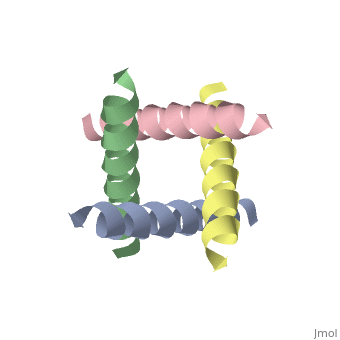M2 Proton Channel from Influenza A Virus
Background
The M2 proton channel is a key protein that leads to viral infection.[1] The M2 proton channel acidifies the virion which allows the viral matrix protein (M1) to disassociate from the ribonucleoprotein (RNP).[2] This allows the RNP to be transported to the nucleus of the cell. Several recent studies have looked at the effects of (Symmetrel)[3] and (Flumadine)[4] on inhibiting the transfer of protons through the M2 channel.[3] Amantadine is a proton surrogate that competes with protons for binding to His37, the residue involved in the gating mechanism.[5][6][7] It has been found that M2 is resistant to these two drugs in 90% of humans, birds and pigs. Understanding the structure and function of this proton channel is necessary in solving the resistance problem.[3]
Animation of Opening and Closing
A morph animation of the H2 proton channel opening and closing is available at Proton Channels.
Structure
The M2 proton channel from influenza A is 97 amino acid residues and forms a 24-residue N-terminal extracellular domain, a 19-residue trans-membrane domain, and a 54-residue C-terminal cytoplasmic domain.[2] The 19-residue TM domain forms the highly selective proton channel.[1] Circular dichroism spectra has shown the TM domain to form an that spans the membrane.[2] By analytical ultracentrifugation, the TM domain is found to form which contains four identical α-helices.[1] Secondary structure is color coded by the following, if present: Alpha Helices, Beta Strands , and Turns. When viewed in the the N-terminus (see scale below) is located near the external side of the membrane while the C-terminus is located near the internal side of the membrane, closest to the virion. This tetrameric bundle of the TM domain is found by NMR to be tilted by 25-38° from the channel axis. The tetrameric helices form a left-handed bundle that resembles a truncated cone. The TM helicies are arranged around the channel pore with an approximate four-fold rotational symmetry.[1]
Central Cavity
The hydrophilic residues in each α-helix monomer are oriented towards the pore lumen. The residues will be in contact with the membrane (Color code= Hydrophobic or Polar). Most of the residues in the M2 channel are hydrophobic except Ser31 Gly34, and His37.[2] The central cavity of the M2 proton channel is most constricted near residue . After this residue, the cavity opens to a water-filled pore that is lined with residues .[3] Mutagenesis studies have found that the residues facing the pore are Val27, Ala30, Ser31, Gly34, His37, Leu38, and Trp41.[2] The central cavity also constricts at residues His37 and Trp41.[3] Residues and play a key role in the gating mechanism.[2] In the closed state, the residues block the channel, preventing proton conductance. [5]
pH Gating
The M2 channel is low-pH gated and has a 50-fold increase in proton conductance when the pH drops from 8.2 down to 4.2.[2] The His side chain, a five-membered ring, has two nitrogen atoms. At a pH of 7 or higher, only one nitrogen is protonated in the neutral imidazole form. However, at a pH of about 5.8, the second nitrogen in one or two helicies becomes protonated and forms the cationic imidazolium form. This protonation causes the His37 residues to move away from each other due to electrostatic repulsion.[1][5][2] The bi-protonated His37 residues are then stabilized by the Trp41 residues by a cation-π interaction. This allows the channel to open and allow water from the pore to penetrate.[5] This forms what is called a proton-conductive water wire through the gate.[2]
Selectivity
Because the N-terminus is very constricted near Val27, the M2 channel is highly selective for protons. The restricted N-terminus only allows protons to penetrate into the aqueous pore through hydrogen-bonded chains of water. Therefore, it would be extremely difficult for hydrated sodium or potassium to penetrate the restricted areas of the M2 channel.[3]
3D structures of proton channel
See proton channel in Ion channels
Additional Resources

